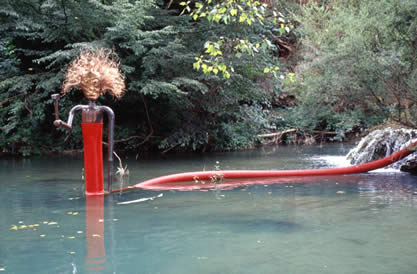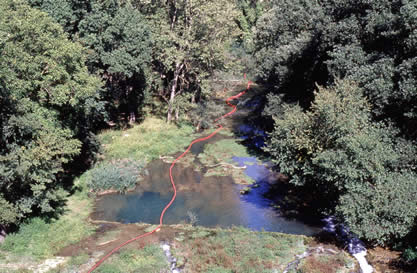| ELSA
Jimmie Durham is a Cherokee, born in Arkansas in 1940. He is a
visual artist, and also a politcal activist for the American Indian
Movement and an essayist. In the ‘60’s and ‘70s
he dedicated his time to theatre and performances, and since the
‘80s he was been creating strange objects, assemblages and
installations that find their principal source in his Native culture,
which he uses to deconstruct the stereotypes and prejudices of
Western culture. For this reason he has already been recognized
as one of the protagonists in the international current that has
anthropology and so-called "postcolonialism" as its
central moments of inspiration. He has participated in several
international exhibitions, such as Documenta IX in 1992, and the
50. Biennale di Venezia. Ironic and shrewd, his work responds
to the sceptisicm of Western culture for different beliefs and
lifestyles with the recovery of materials and found forms: a plastic
tube or a stick are not a serpent, but they can act as one, as
they reanimate the situation they are placed in. Man is surely
a part of nature that includes everything. However, postmodernly,
couldn't the artificiality of certain materials that are integrated
in his objects, the flirtation with kitsch of the common idea
that one has of Natives and their culture, the history of the
assemblage form, and the cross-reference with the "primitivism"
of 20th century art, be keys to the irony with which Durham looks
at himself as well? And doesn't this turn the prospective upside-down
in an indication for the future instead of an impossible search
for roots that are too buried by time? For Arte all'Arte Durham
has created a sculpture of the Spirit of the Elsa River, with
various materials and with a tecnique that evokes the tradition
of ancient saints sculpted in woods, similar to prehistoric figures.
The spirit, with long Gorgon hair, a large hammer in its hand,
emerges from a long "serpent" with a body made of industrial
PVC, which stands out against the waters of the river, and like
the river, gets progessively longer. What is a spirit? What is
a river?
 Jimmie Durham, Elsa, 2003
Jimmie Durham, Elsa, 2003
Bridge of San Marziale, Colle di Val d’Elsa
Project for Arte all’Arte 2003
Photo Ela Bialkowska, view of the installation
 Jimmie Durham, Elsa, 2003
Jimmie Durham, Elsa, 2003
Bridge of San Marziale, Colle di Val d’Elsa
Project for Arte all’Arte 2003
Photo Ela Bialkowska, view of the installation
Jimmie Durham’s Museum of Paper
The Museum is not only a place of conservation and presentation
of historic objects, documents and images. In fact, it’s
main function is to provide a certain authority of knowledge through
its internal activities such as collecting, selecting, categorizing,
framing, presenting and propagating objects, texts and images,
etc. This process is supposed to demonstrate the "authenticity"
of historic materials. However, it’s by no means a neutral
one. Instead, it represents directly and indirectly certain ideologies
and historic conditions and legitimates the dominance of cultural
and political powers.
Jimmie Durham’s artistic work and intellectual engagements
have systematically focusing on questioning the global hegemony
of modern Western system of knowledge, or the "authentic"
order of things. The museum represents such a hegemony in most
perfect form while it is generally considered the ultimate space
for artistic consecration. Deeply impressed by the abandoned paper
factory in Colle Val d’Elsa, Durham decides to turn it into
a "Museum of Paper". Collecting all kinds of found papers,
ranging from popular pedagogic books to wall papers, from scraps
of posters to hand-written notes, from art works to rubbish, etc.
Durham has mounted a totally "chaotic" representation
of papers, the very incarnation of "civilization". The
melange of these scraps, in turn, subverts the essential order
of the hegemonic power of modern culture embodied by the museum
itself. In the meantime, this critique has been realised in a
kind of aesthetic dynamism driven by irony, humour, poetry and
lightness.
|
|


